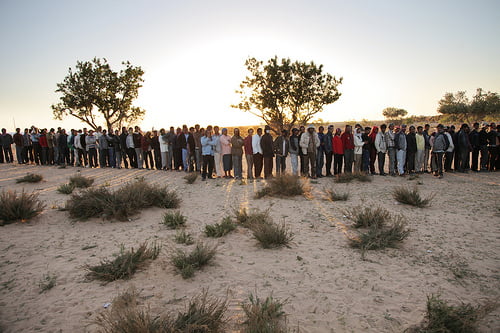Journalists Tim Hetherington and Chris Hondros, who were killed in the battle for Tripoli Street in Misurata, Libya, yesterday were soaring down a road of fate few can understand. Rather than heading toward a life of comfort and prosperity, Hetherington and Hondros chose careers in which success led instead toward increasing uncertainty, trauma, and potentially only an art house theater of fans.
Why on earth would they continually run toward the sound of gunfire, pop their heads up to take photographs, and then run back through fire to get online and send those photos to editors who could give no guarantee they would run the shots?
There’s no way to know all the personal reasons of each photographer. On the public level, we can guess that most likely Hetherington, Hondros, and others who have been killed documenting war have risked everything to ensure that concerned global citizens watching the horrible events unfold in Libya, Afghanistan, Iraq, and other places are able to take action based on a full spectrum of understanding about what is happening on the ground. It is a form of public service. Photographs of generals giving press conferences or refugees standing in line simply do not inform us the way we are informed, frightened, and perhaps enriched by photo essays of soldiers fighting, getting wounded, and arriving to makeshift hospitals to find themselves among children hit in the crossfire.
My colleagues and I at the new creative humanitarian media site, HELO Magazine, were ecstatic to bring war journalist Tim Hetherington into our extended family just a few weeks ago. Co-founder Hilaire Avril and I had admired Hetherington’s work for some time. He had not only co-directed the Afghanistan war film, Restrepo, but also had created, Diary, perhaps the film that best represents how working as a crisis responder really feels.
After seeing Diary, our team talked about how this kind of creative, deeply emotional approach to documenting crisis represented exactly what we sought to achieve ourselves. We were so glad to introduce the project to Hetherington and learn from him. Just weeks before his death, Hetherington talked about how and why he created Diary. The talk revealed some incite into his more personal reasons for – and effects of choosing – a life as a war journalist:
“The initial idea was simply to build a visual diary,” Hetherington told HELO regarding the short film. “I kept shooting and adding bits for years, a bit like in the Bayeux tapestry [the 70-metre long tapestry depicting the brutal 11th-century Norman invasion on England]. I edited it for years and ended up with about 70 hours end-to-end. But I thought that would only be fit for display in some obscure art gallery. It was too indulgent.
“The spark came when my book Liberia Retold [which “entwines documentary photography, oral testimony, and memoir to map the dynamics of power, tragedy and triumph in Liberia’s recent history”] was released in 2009, for which I was interviewed by the BBC. The journalist was looking into artists and photographers who face ethical challenges. I showed her rushes, and she was deeply shocked by the violence of some of the footage. Her reaction shocked me in turn. What she found disturbing didn’t disturb me at all. I started wondering what covering this had done to me. What was happening to me?”
C.J. Chivers of the New York Times, who was reporting near Hetherington and Hondros when they were struck by a rocket or mortar, provides the details of what happened. For more, also see Chris Hondros’ photography on the New York Times and Getty Images. His work on Getty Images chronicles the journalist team’s last few stories up to the day they were hit.
Photo: Libyan refugees on border (UN Photo / David Ohana / CC).
